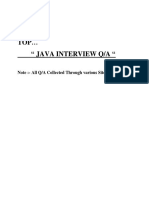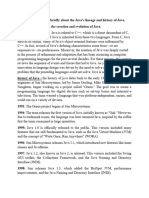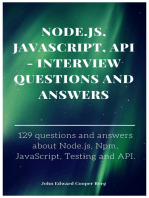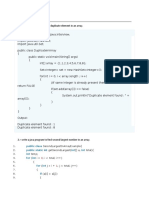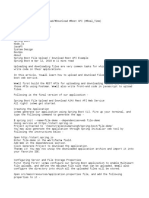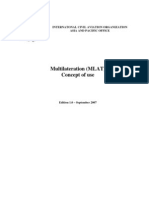Sapient Interview Question Answer
Sapient Interview Question Answer
Uploaded by
Radheshyam NayakCopyright:
Available Formats
Sapient Interview Question Answer
Sapient Interview Question Answer
Uploaded by
Radheshyam NayakCopyright
Available Formats
Share this document
Did you find this document useful?
Is this content inappropriate?
Copyright:
Available Formats
Sapient Interview Question Answer
Sapient Interview Question Answer
Uploaded by
Radheshyam NayakCopyright:
Available Formats
Hi Team,
#Today's uploaded
#Sapient #Interview #Questions and# Answers for #Java 2 - 6 Year #Experience
#Sapient #Interview #questions for #Java #experience #candidate - 2 -6 #years.....
Q1) Tell me about yourself!!!
Ans � Give your brief introduction with full confidence.
Q2) What are the types of class loaders in Java ?
Ans � View Answer.
Q3) How to read and write image from a file ?
Ans � By the use of ImageIO.read() and ImageIO.write() method of javax.imageio
package.
Q4) What is difference between static and init block in Java ?
Ans � View Answer.
Q5) What is ConcurrentMap and how it works?
Ans � It�s a Map which providing thread safety and atomicity guarantees. For Memory
consistency it works with other concurrent collections, actions in a thread prior
to placing an object into a ConcurrentMap as a key or value happen-before actions
subsequent to the access or removal of that object from the ConcurrentMap in
another thread.
Q6) Can a static block throw exception?
Ans � Yes. We can throw checked exception.
Q7) What is difference between iterator access and index access?
Ans - Basically iterator access process the traverse operation through each
element, where index access process access direct the element by using the index.
Q8) Why character array is better than string for storing password in Java?
Ans � Security !!! Because, character array stores data in encrypted format which
is not readable by human. But, the string stores the data in human readable format
which is not secure.
Q9) What is the difference between Serializable and Externalizable interfaces ?
Ans - Both interfaces are used for implement serialization. But, the basic
difference is Serializable interface does not have any method (it�s a
marker interface ) and Externalizable interface having 2 methods such as
readExternal() and writeExternal(). Serializable interface is the super
interface for Externalizable interface.
Q10) Which Interface is used to make duplicate of Objects ?
Ans � Cloneable interface.
Q11) What are some advantages and disadvantages of Java Sockets?
Ans � The main advantage is its flexible and very efficient during low network
bandwidth. Also its helpful for debugging and some kind of testing. But, security
is the most disadvantages. Its always recommended to be careful when
authenticating.
Q12) When can an object reference be cast to an interface reference?
Ans �Yes its possible, when that interface is implemented by that class.
Example � MyInterface obj=new MyClass();
obj.callMethod();
Q13) How does Java allocate stack and heap Memory?
Ans � As we know stack memory is not dynamic and its follows LIFO order. Java
provides similar implementation for memory allocation. Normally all local variables
are created in Stack area (memory) and objects (reference types) are created in
heap memory (heap area) .Even all primitive types allocated in stack memory. Heap
area is dynamic and handled by JVM runtime. Heap memory is cleaned by garbage
collector at runtime.
Q14) What is memory leak in Java?
Ans � Usually memory leak leads to waste of memory. In general memory leak defines
the unavailability of referenced memory. It causes the Garbage collector to fail to
collect that object.
Q15) Can we throw exception from finally block in Java?
Ans � Yes, but you need to mentioned �throws� on the method head.
Example �
public static void main(String[] args) throws Exception {
// TODO Auto-generated method stub
TestInterface2 interObj=new InterfaceObject();
try{
interObj.display();
}catch(Exception e){
System.out.println("Exception handled...");
}finally{
throw new Exception("This is exception");
}
}
Q16) How does Java handle integer overflows and underflows?
Ans � Yes, java handles overflows and underflows very intelligently. When it
overflows it will go to MIN_VALUE (i.e. -231 ) and when it underflows to will go to
MAX_VALUE (i.e. 231-1) .
Q18) What is casting?
Ans � Casting means conversion. Basically we need casting to type cast the type.
There are two types of casting by java i.e. explicit casting and implicit casting.
Q19) What is new in JSP?
Ans � As per my knowledge JSP 2.1 has many new functionalities. It support resource
injection via annotation. It has few extended support for java standard tag
library. Also literal expression is supported by JSP 2.1 EL and many other
additional features.
Q20) What do you mean by Java Reflection ?
Ans � It provides runtime access to JVM. Reflection is one of the most powerful API
which help to work with classes, methods and variables dynamically at runtime.
Basically it inspects the class attributes at runtime. Also we can say it provides
a metadata about the class.
Q21) Why does the InputStreamReader class has a read() ?
Ans � Because, an InputStreamReader is a bridge from byte streams to character
streams: It reads bytes and decodes them into characters using a specified charset.
The charset that it uses may be specified by name or may be given explicitly, or
the platform's default charset may be accepted. It has two overloaded read() method
. Each invocation of one of an InputStreamReader's read() methods may cause one or
more bytes to be read from the underlying byte-input stream. To enable the
efficient conversion of bytes to characters, more bytes may be read ahead from the
underlying stream than are necessary to satisfy the current read operation.
Q22) Describe a problem you faced and how did you solve that?
Ans - You can describe any issue you faced during your project work in the
organization. And what the solution you have implemented for that issue
You might also like
- Renewal Assessment For Microsoft Certified Azure Solutions ArchitectDocument15 pagesRenewal Assessment For Microsoft Certified Azure Solutions ArchitectKas Shah67% (9)
- OpenText Documentum XCelerated Composition Platform CE 22.2 - Deployment Guide English (EDCPKL220200-IGD-En-01)Document248 pagesOpenText Documentum XCelerated Composition Platform CE 22.2 - Deployment Guide English (EDCPKL220200-IGD-En-01)nippanisasiNo ratings yet
- MG6HK WE 0221manual MotorDocument293 pagesMG6HK WE 0221manual MotorWilliam Giovanni Madariaga Malebrán100% (5)
- Flathead EngineDocument5 pagesFlathead Engineshapoor_pouladiNo ratings yet
- Java Core Interview Questions and Answers. Tech interviewer’s notesFrom EverandJava Core Interview Questions and Answers. Tech interviewer’s notesRating: 1 out of 5 stars1/5 (1)
- Agile Scrum Interview QuestionDocument3 pagesAgile Scrum Interview QuestionRadheshyam NayakNo ratings yet
- Agile Scrum Interview QuestionDocument3 pagesAgile Scrum Interview QuestionRadheshyam NayakNo ratings yet
- Agile Scrum Interview QuestionsDocument20 pagesAgile Scrum Interview QuestionsRadheshyam NayakNo ratings yet
- Factory Method .NET Design Pattern in C# and VB - DofactoryDocument10 pagesFactory Method .NET Design Pattern in C# and VB - DofactoryChun Ming Jeffy Tam100% (1)
- Risk Management For CQEDocument25 pagesRisk Management For CQEAhmed M. HashimNo ratings yet
- Basic InterviewDocument7 pagesBasic InterviewsathishsgrNo ratings yet
- Java Interview Q & ADocument26 pagesJava Interview Q & Arakeshlr1996No ratings yet
- Java 2Document3 pagesJava 2umamucheli34No ratings yet
- Garbage Collection Is One of The Most Important Feature of Java, Garbage Collection Is Also CalledDocument7 pagesGarbage Collection Is One of The Most Important Feature of Java, Garbage Collection Is Also Calledkalicharan13No ratings yet
- Java Interview QuestionsDocument11 pagesJava Interview QuestionsSanal PillaiNo ratings yet
- UipathDocument21 pagesUipathmainak dasNo ratings yet
- Top 371 Java FAQs Useful For Freshers and ExperiencedDocument55 pagesTop 371 Java FAQs Useful For Freshers and ExperiencedJavaEra.com86% (14)
- Java Interview QuestionsDocument20 pagesJava Interview Questionstadefef573No ratings yet
- TOP Java QA PDFDocument16 pagesTOP Java QA PDFSatyanarayana ChavsNo ratings yet
- Core Java Q1. What Is The Difference Between An Abstract Class and Interface?Document233 pagesCore Java Q1. What Is The Difference Between An Abstract Class and Interface?kuldeep1985No ratings yet
- Java Faq'sDocument181 pagesJava Faq'sheram6007No ratings yet
- Q1. What Is The Difference Between An Abstract Class and Interface?Document13 pagesQ1. What Is The Difference Between An Abstract Class and Interface?abhida123No ratings yet
- 100 Core Java Interview Questions PDFDocument25 pages100 Core Java Interview Questions PDFvenkateshNo ratings yet
- Java Python Interview QuestionsDocument33 pagesJava Python Interview Questionsnagardone8919No ratings yet
- 1) What Is The Difference Between An Abstract Class and Interface?Document8 pages1) What Is The Difference Between An Abstract Class and Interface?Janelle Zimmerman-HrpcekNo ratings yet
- Cognizant Interview Questions For Java Developers: What Is A Singleton in Java?Document5 pagesCognizant Interview Questions For Java Developers: What Is A Singleton in Java?DhyanaNo ratings yet
- Java Is A Strongly Typed LanguageDocument19 pagesJava Is A Strongly Typed LanguageK-link BanglaNo ratings yet
- Java All 36Document84 pagesJava All 36r1ujm3ik68No ratings yet
- Web Technology (Short Notes)Document84 pagesWeb Technology (Short Notes)Bhuvnesh KumarNo ratings yet
- Abstraction Interview Questions - JavatpointDocument16 pagesAbstraction Interview Questions - JavatpointSaagar MinochaNo ratings yet
- Top 100 JAVA Interview Question & AnswersDocument14 pagesTop 100 JAVA Interview Question & AnswersVinoth ChinNo ratings yet
- Answer : Find Missing Element in List of ArrayDocument3 pagesAnswer : Find Missing Element in List of Arraymadhavi uNo ratings yet
- Top Java Interview Q/ADocument32 pagesTop Java Interview Q/ASample OneNo ratings yet
- Java 70 SheetDocument26 pagesJava 70 SheetAlishad KhanNo ratings yet
- 100+ Core Java Interview QuestionsDocument30 pages100+ Core Java Interview Questionsanupam20099No ratings yet
- Experience Faqs (Final)Document35 pagesExperience Faqs (Final)Srinivas Malliboina0% (1)
- Using Setsecuritymanager MethodDocument3 pagesUsing Setsecuritymanager MethodSunil SuryawanshiNo ratings yet
- Java - All The Modern Buzzwords: SimpleDocument37 pagesJava - All The Modern Buzzwords: SimpleNeha Chack100% (1)
- Java QuestionsDocument19 pagesJava QuestionsMayur DarkundeNo ratings yet
- Java Faq MaterialDocument86 pagesJava Faq Materialrajesh7javaNo ratings yet
- Basic Java Interview QuestionsDocument37 pagesBasic Java Interview QuestionsSaravana NatarajanNo ratings yet
- Basic Java Interview Questions: by Admin - October 9, 2004Document2 pagesBasic Java Interview Questions: by Admin - October 9, 2004Satchit NisankaNo ratings yet
- 03 - Multithreading FAQDocument4 pages03 - Multithreading FAQrajay2r1548No ratings yet
- OM JavaDocument10 pagesOM JavaadobeindustrialsystemsNo ratings yet
- QP WEBTDocument4 pagesQP WEBTdivyanshNo ratings yet
- Question: Language Features - OO RulesDocument22 pagesQuestion: Language Features - OO RulesAnkit JainNo ratings yet
- Java Unit 1Document17 pagesJava Unit 1pandu mandalaNo ratings yet
- Nov Dec 19Document26 pagesNov Dec 19Sheryl VinibaNo ratings yet
- JAVA Basics Who Developed Java?: Platform IndependenceDocument10 pagesJAVA Basics Who Developed Java?: Platform IndependencesaithejaNo ratings yet
- Read Me - I Am Bundle of Important Questions Basics To OopsDocument18 pagesRead Me - I Am Bundle of Important Questions Basics To Oopssunil kumar dashNo ratings yet
- Per Connection? - NoDocument8 pagesPer Connection? - NoSathish BscNo ratings yet
- Top 100 JAVA Interview Question AnswersDocument15 pagesTop 100 JAVA Interview Question AnswersOjas Dhone100% (1)
- Code Snippets and Tips: CategoriesDocument5 pagesCode Snippets and Tips: CategoriesArpit GuptaNo ratings yet
- Interview Questions C and JavaDocument39 pagesInterview Questions C and JavaSaiKrishnaNo ratings yet
- Java Swing Components Are Not Thread-Safe in JavaDocument4 pagesJava Swing Components Are Not Thread-Safe in JavaSunil SuryawanshiNo ratings yet
- 1) What Is Java?Document11 pages1) What Is Java?Jijitha MjNo ratings yet
- Nov Dec 18Document20 pagesNov Dec 18Sheryl VinibaNo ratings yet
- Java Questions AnswersDocument68 pagesJava Questions AnswersAbraham FidouNo ratings yet
- IT2301 2markDocument10 pagesIT2301 2marksampathaboNo ratings yet
- Java Interview QuestionsDocument8 pagesJava Interview QuestionsANIL KUMAR SAMALNo ratings yet
- Top 100 Java Interview QnA? ?Document17 pagesTop 100 Java Interview QnA? ?sunil.bellalaNo ratings yet
- Java Ques AnseDocument39 pagesJava Ques Ansesumit86No ratings yet
- Java Interview QuestionsDocument6 pagesJava Interview QuestionsKishore BabuNo ratings yet
- Java VivaDocument12 pagesJava VivaBunny BunnyNo ratings yet
- Java Multithreading Interview Questions And AnswersFrom EverandJava Multithreading Interview Questions And AnswersNo ratings yet
- Java Package Mastery: 100 Knock Series - Master Java in One Hour, 2024 EditionFrom EverandJava Package Mastery: 100 Knock Series - Master Java in One Hour, 2024 EditionNo ratings yet
- Java Core Interview in Australia. Questions and Answers. Tech interviewer’s notesFrom EverandJava Core Interview in Australia. Questions and Answers. Tech interviewer’s notesNo ratings yet
- Node.js, JavaScript, API: Interview Questions and AnswersFrom EverandNode.js, JavaScript, API: Interview Questions and AnswersRating: 5 out of 5 stars5/5 (1)
- Mastering Java: A Golden Collection of Questions & Answers for Success: Java: 200 Key Questions for a strong programming baseFrom EverandMastering Java: A Golden Collection of Questions & Answers for Success: Java: 200 Key Questions for a strong programming baseNo ratings yet
- Template Method Design PatternDocument3 pagesTemplate Method Design PatternRadheshyam NayakNo ratings yet
- Spring Boot Project QuestionDocument3 pagesSpring Boot Project QuestionRadheshyam Nayak100% (1)
- SQL Interview QuestionsDocument9 pagesSQL Interview QuestionsRadheshyam Nayak100% (1)
- 100 - Java 8 Interview Questions & AnswersDocument15 pages100 - Java 8 Interview Questions & AnswersRadheshyam Nayak100% (1)
- Zoho Interview QustionsDocument4 pagesZoho Interview QustionsRadheshyam Nayak0% (1)
- Java Full Package InterviewDocument18 pagesJava Full Package InterviewRAMKRUSHNA NAYAKNo ratings yet
- 2 CustomContentHandlersDocument14 pages2 CustomContentHandlersRadheshyam NayakNo ratings yet
- 2.3 Developing The Async JAX-RS ResourceDocument10 pages2.3 Developing The Async JAX-RS ResourceRadheshyam NayakNo ratings yet
- HeapSort in Real - TimeDocument5 pagesHeapSort in Real - TimeRadheshyam NayakNo ratings yet
- Accenture Interview Question AnswerDocument1 pageAccenture Interview Question AnswerRadheshyam NayakNo ratings yet
- Spring Batch 4.0.0Document79 pagesSpring Batch 4.0.0Radheshyam NayakNo ratings yet
- Generating Userid and Password in JavaDocument2 pagesGenerating Userid and Password in JavaRadheshyam NayakNo ratings yet
- Convert JavaObject To JSONDocument2 pagesConvert JavaObject To JSONRadheshyam NayakNo ratings yet
- Array Interview ProgramsDocument6 pagesArray Interview ProgramsRadheshyam NayakNo ratings yet
- AWS DevOps Interview QuestionAnswerDocument10 pagesAWS DevOps Interview QuestionAnswerRadheshyam Nayak100% (1)
- Jenkins Tool Interview QustionsDocument4 pagesJenkins Tool Interview QustionsRadheshyam NayakNo ratings yet
- 100 - Java 8 Interview Questions & AnswersDocument15 pages100 - Java 8 Interview Questions & AnswersRadheshyam Nayak100% (1)
- Singleton Design PatternDocument3 pagesSingleton Design PatternRadheshyam NayakNo ratings yet
- MicroService Project Interview QuestionDocument5 pagesMicroService Project Interview QuestionRadheshyam NayakNo ratings yet
- Spring Boot File Upload DownloadDocument12 pagesSpring Boot File Upload DownloadRadheshyam NayakNo ratings yet
- Web Logic Interview QuestionAnswerDocument2 pagesWeb Logic Interview QuestionAnswerRadheshyam NayakNo ratings yet
- Multilateration (MLAT) Concept of Use: Internatonal Civil Aviation Organization Asia and Pacific OfficeDocument19 pagesMultilateration (MLAT) Concept of Use: Internatonal Civil Aviation Organization Asia and Pacific Officertomka100% (1)
- Ecu Miu-G3 TrainingDocument35 pagesEcu Miu-G3 TrainingjonnydiggleNo ratings yet
- The Father of Invention - Dick Morley Looks Back On The 40th Anniversary of The PLC - Manufacturing AUTOMATIONDocument3 pagesThe Father of Invention - Dick Morley Looks Back On The 40th Anniversary of The PLC - Manufacturing AUTOMATIONJavi Er PinalesNo ratings yet
- DOCUMENTATION-quiz Software Management SystemDocument19 pagesDOCUMENTATION-quiz Software Management SystemVaibhav ChandraNo ratings yet
- Resume ManagerDocument1 pageResume ManagerShrinivethika BalasubramanianNo ratings yet
- Tools and Technology DevopsDocument24 pagesTools and Technology DevopsAmitha R HNo ratings yet
- cst438 MidtermDocument7 pagescst438 Midtermapi-559045701No ratings yet
- PPT08 Securing Information SystemsDocument53 pagesPPT08 Securing Information SystemsyarenNo ratings yet
- Chapter 1 & 2 - IntroToProgrammingDocument28 pagesChapter 1 & 2 - IntroToProgrammingNor syaza syafmiza binti zulkifliNo ratings yet
- Chapter 4 Defining The ProjectDocument31 pagesChapter 4 Defining The ProjectKunal SehgalNo ratings yet
- Unit 1 - Lab 1-FlowchartDocument6 pagesUnit 1 - Lab 1-FlowchartSon DavidNo ratings yet
- Aircraft Maintenance - SKYbrary Aviation SafetyDocument4 pagesAircraft Maintenance - SKYbrary Aviation SafetyHarris Dian100% (1)
- An Integrated Model-Based Approach To System Safety and Aircraft System Architecture DevelopmentDocument21 pagesAn Integrated Model-Based Approach To System Safety and Aircraft System Architecture DevelopmentSivasankar AkcNo ratings yet
- Safety Instrumented Systems: A Comprehensive E-Learning Course (With Free Online Exam & Certification) OnDocument8 pagesSafety Instrumented Systems: A Comprehensive E-Learning Course (With Free Online Exam & Certification) OnIrfan ShaikNo ratings yet
- 13 Software Development ModelsDocument37 pages13 Software Development ModelsInfo PlusNo ratings yet
- Namma Kalvi 12th Computer Science Chapter 1 Diamond Guide emDocument11 pagesNamma Kalvi 12th Computer Science Chapter 1 Diamond Guide emAakaash C.K.No ratings yet
- PYTHONPPTDocument65 pagesPYTHONPPTG.LAKSHIMIPRIYA Dept Of Computer ScienceNo ratings yet
- (IAC) Ilswcati&Iirwy15: CURITIBA / Afonso Pena, INTL (SBCT) Chart Instrument ApproachDocument1 page(IAC) Ilswcati&Iirwy15: CURITIBA / Afonso Pena, INTL (SBCT) Chart Instrument ApproachMichael NevesNo ratings yet
- BindhuSri ResumeDocument2 pagesBindhuSri ResumeKarThikNo ratings yet
- LogDocument14 pagesLogMiftahul JannahNo ratings yet
- Technical Review Agap2 - Last Name First NameDocument9 pagesTechnical Review Agap2 - Last Name First NameAlex Criado GomezNo ratings yet
- MULESOFT DEVELOPMENT - InterviewDocument21 pagesMULESOFT DEVELOPMENT - InterviewAnitha ReddyNo ratings yet
- USDPDocument42 pagesUSDPSachin RanaNo ratings yet
- De 2 - ISTQBDocument8 pagesDe 2 - ISTQBNắng Bình YênNo ratings yet

















